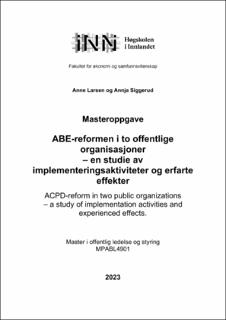| dc.contributor.advisor | | |
| dc.contributor.author | Larsen, Anne | |
| dc.contributor.author | Siggerud, Annja | |
| dc.date.accessioned | 2023-07-05T16:11:08Z | |
| dc.date.available | 2023-07-05T16:11:08Z | |
| dc.date.issued | 2023 | |
| dc.identifier | no.inn:inspera:148100067:51731800 | |
| dc.identifier.uri | https://hdl.handle.net/11250/3076210 | |
| dc.description.abstract | ABE-reformen kuttet 0,5-0,8 % av bevilgningen til statlige organisasjoner fra 2015 til 2022. Hensikten med reformen var å effektivisere og avbyråkratisere statlige organisasjoner. Forutsigbare årlige kutt skulle gi organisasjonene insentiver til drive mer effektivt, mens de frigjorte midlene skulle tilbakeføres til fellesskapet for å skape handlingsrom til å finansiere andre satsinger.
Vi har studert hvordan to organisasjoner arbeider med kuttene, og hvilke effekter reformen har. Dette gjør vi ut fra tre perspektiv: Det instrumentelle perspektivet, kulturperspektivet og myteperspektivet (Christensen et al., 2015). Begge organisasjoner setter i gang og gjennomfører en rekke implementeringsaktiviteter i perioden 2015-2022. Det er felles at begge organisasjoner starter med kutt i driftsbudsjettet etter ostehøvelprinsippet, og også at begge organisasjoner følger opp med tiltak som kunngjøringsstopp i administrative stillinger. Videre leier begge organisasjoner inn konsulentselskaper. Til slutt er det et fellestrekk at ABE-reformen ikke kan ses som en isolert hendelse i noen av organisasjonene. Særlig må implementeringen ses i sammenheng med strukturreformen i høyere utdanning og sammenslåing av tingretter med felles ledelse. Digitalisering av arbeidsprosesser og tjenester har vært en klar forventning fra bevilgende myndigheter gjennom flere år, og har klar sammenheng med reformen. I tillegg har koronapandemien påvirket både økonomi og arbeidsmåter. Vi ser at alle de tre perspektivene er nødvendige for å forklare implementeringsaktiviteter og effekter. | |
| dc.description.abstract | The ACPD reform (ABE-reform in Norwegian) cut 0.5-0.8% of the allocation to governmental agencies from 2015 to 2022. The purpose of the reform was to streamline and de-bureaucratize the agencies. Predictable annual cuts should give the organizations incentives to operate more efficiently, while the released funds should be returned to the community and allocated to other purposes.
We have studied how two organizations work with the cuts, and what effects the reform has. We do this from three perspectives: The instrumental perspective, the cultural perspective, and the myth perspective (Christensen et al., 2015). Both organizations initiate and carry out several implementation activities in the period 2015-2022. The two organizations have in common that they initiate flat cuts in the operating budgets in the beginning, and it also applies for both organizations that they follow up with measures such as to freeze announcement in administrative positions. Furthermore, both organizations hire consulting companies. Finally, it is a common feature that the ABE reform cannot be seen as an isolated event in any of the organizations. In particular, the implementation must be seen in the context of the structural reform in higher education and the merger of district courts with joint management. Digitization of work processes and services has been a clear expectation from the granting authorities for several years, and it has a clear connection with the reform. In addition, the corona pandemic has affected both the economy and working methods. We see that all three perspectives are necessary to explain implementation activities and effects. | |
| dc.language | nob | |
| dc.publisher | Inland Norway University | |
| dc.title | ABE-reformen i to offentlige organisasjoner
– en studie av implementeringsaktiviteter og erfarte effekter | |
| dc.type | Master thesis | |
